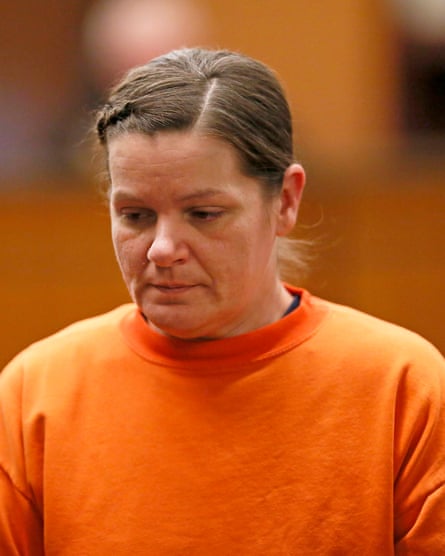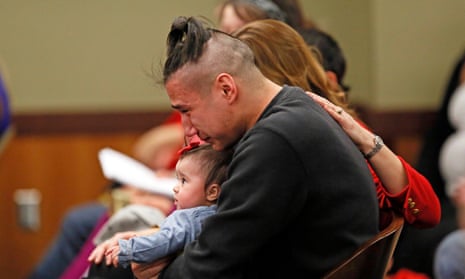There was heartbreak across Indian country in August 2017 when the body of 22-year-old Savanna LaFontaine-Greywind was found duct-taped in plastic in the Red River.
The ribbon of water demarcates North Dakota from Minnesota, a tributary flowing northward across the Canadian border. It is where, a few years earlier, an indigenous girl, 15-year-old Tina Fontaine, was discovered wrapped in a duvet cover and weighted down by rocks.
The tales of these two tragedies and the river itself are emblematic of a modern violence against one of the world’s most vulnerable populations, indigenous women and girls. It is a problem police and authorities in the US have been accused of ignoring.
The river, over the decades, has come to be seen by many in the indigenous community as a dumping ground for discarded bodies, but their sense is that detectives don’t take this seriously. Loved ones of the missing started to drag the Red on their own starting in 2014 after finding Fontaine. That year, advocates say they pulled seven bodies from the river.
Indigenous women in the United States and Canada are murdered, vanished or found dead without explanation at rates well above national per capita averages. Advocates on both sides of the border blame the crisis on a lack of specialized investigative policing as well as extreme gaps in government oversight.
Others are more blunt and call the problem something else: racism, a discrimination breeding distrust in authorities among indigenous peoples. The discord suggests that whatever statistics are known are likely a disturbing undercount. Crimes are unreported and when they are, incidents often lack essential data and facts.
But unlike Canada, the US lags behind in awareness and action to curb the injustice. Fontaine, whose death is still unexplained, renewed calls by First Nations activists for a national inquiry into the broader issue – a cause the Canadian prime minister, Justin Trudeau, committed to in 2017. The nearly two-year investigation concluded in December. A report is expected to be released in June.
It is unclear just how extensive the problem is in the US. A review of the FBI’s 2017 violent crime report lists incidents that occur on tribal lands but does not tell anything about the gender or ethnicity of the victims.
Statistics from the Centers for Disease Control and Prevention suggest that young Native American women are less likely than other women to be victims of homicide. Advocates argue that such statistics may reflect poor data collection, not less violence.
The murder of LaFontaine-Greywind sparked a national outrage in America, and last year, a bill named after her became the first in Congress to propose increasing coordination among federal, state and tribal law enforcement to curb the chronic rate at which indigenous women go missing or are slain. However, passing Savanna’s Act has been on an uneven path.
In August 2017, during her last month of pregnancy, LaFontaine-Greywind, whose Dakota name is “Where Thunder Finds Her”, placed a pizza delivery order to her family’s Fargo apartment before heading upstairs to see a neighbor. It was the last time her parents would see their daughter alive.
Kayakers found the Spirit Lake Nation woman eight days later. Her baby had been cut from her womb. Police had found the healthy newborn 72 hours earlier on the bed of her neighbor, Brooke Crews. The woman was arrested, pleaded guilty and was sentenced to life without parole. Her live-in boyfriend, William Hoehn, was also sentenced to life for conspiring to kidnap Savanna’s baby, Haisley Jo.
Justice was swiftly served in the aftermath of LaFontaine-Greywind’s death, a rare outcome. So many other cases have turned cold.
Please RT. Progress on the Savanna Lafontaine-Greywind Missing Person Case. #FindSavanna pic.twitter.com/9wl7C8YxEP
— Fargo Police (@FargoPolice) August 24, 2017
Family and mourners felt the Fargo police department had reacted too slowly to her disappearance. The chief of police, David Todd, indicated that the investigation may have gone differently if the force knew they were looking for someone who had died. Tribal leaders across the state demanded reform.
Dave Flute is the chairman of the Sisseton-Wahpeton Oyate Nation and leads the United Tribes of North Dakota, a leadership coalition representative of the state’s five-federally recognized tribal nations.
“During the gatherings and prayers for Savanna, we heard story after story from families who also have women in their families missing or with unsolved murders,” said Flute in a letter addressed to North Dakota’s congressional delegation in the weeks following LaFontaine-Greywind’s death. “The murder of Savanna illustrates a much larger problem of epic proportions.”
In the letter sent on behalf of the tribes, leaders outlined 10-points of action for lawmakers to consider. Today, it serves as an aspirational checklist to gauge progress on the violence faced by indigenous women and girls.
Heidi Heitkamp, the former senator of North Dakota, wasted little time responding to the checklist.

“For too long, the disproportionate incidences of violence against Native women have gone unnoticed, unreported or underreported and it’s time to address this issue head on,” said Heitkamp on the day she introduced Savanna’s Act on the Senate floor in Washington DC, just six weeks after LaFontaine-Greywind’s body was pulled from the Red River.
A year later in the run-up to the midterm elections in November 2018, Heitkamp was defeated by Kevin Cramer, North Dakota’s sole congressional representative. With the clock ticking on her time in Washington, Heitkamp doubled-down on her signature legislation.
Savanna’s Act passed the Senate in the final days of the 115th Congress, but the bill was ultimately blocked by a single vote. The Republican congressman Bob Goodlatte of Virginia opposed certain provisions, which sent Heitkamp’s proposal back to square one.
Heitkamp, who prosecuted sexual assault cases as North Dakota’s attorney general and whose mother was a survivor of sexual violence, told the Guardian the failure left her with “heartache”.
“We could have gotten it done at the end of last year. We’d be already, how many months into enforcement and implementation?” Heitkamp said.
The Senator Lisa Murkowski of Alaska reintroduced the bill in January. The proposed legislation would improve and increase access to data on Native American crime victims, establish police protocols and require annual reports to Congress on the number of missing and slain Native American women.
Amendments made to Savanna’s Act also expanded its reach to include non-reservation based communities after the Urban Indian Health Institute pointed out that the bill was an incomplete solution because it did not include urban women – such as LaFontaine-Greywind herself. Nearly three-quarters of Native Americans do not live on reservations but in cities and border towns across the US.

Those expansions outlined in Savanna’s Act would mean that police resources – including vital funding – would work to include collaborative efforts across jurisdictions but without an increase in appropriations, which had been a key reason for Goodlatte’s objection, he said.
Despite co-sponsoring Savanna’s Act in January, Senator Cramer has also said he wanted changes made to the bill so it doesn’t “disadvantage law enforcement agencies”.
Should passage of Savanna’s Act meet challenges again, there are several other pieces of pending legislation at the federal and state level which address gender violence against indigenous women, including the recently introduced Not Invisible Act sponsored by Murkowski, a Republican, and Democratic senators Catherine Cortez Masto and Jon Tester.
Like Savanna’s Act, the Not Invisible bill goes a step further in calling for an advisory committee of local, tribal and federal stakeholders to examine best steps in stemming violent crime and human trafficking of Native women. The namesake of the bill was inspired by a celebrity-driven #NotInvisible social media campaign initiated by Heitkamp in 2017, although few advocates in Indian country have adopted the hashtag.
“Despite the narrative, it’s still being shaped by those on the outside,” said Abigail Echo-Hawk, the director of the Urban Indian Health Institute based in Seattle and a tribal citizen of the Pawnee Nation.
But Echo-Hawk gives credit to congresswoman Deb Haaland of New Mexico – one of the first Native American women elected to Congress – for advocating for nuanced legislation more reflective of Indian country. In the days leading up to a House vote approving the reauthorization of the Violence Against Women Act earlier this month, Haaland was able to add language which would provide victim advocate services to urban Indians in the state courts.
Indigenous political representation is a hopeful sign for advocates like Echo-Hawk who complain that policies impacting Indian country have for too long resulted in half-measured solutions.
“The calls for various task forces to be set up and awareness days being implemented are great, but that’s not enough,” said Echo-Hawk.
Like many advocates across Indian country who are invested in the “missing and murdered” advocacy movement, there is a watchful gaze on Canada and the anticipated national inquiry report inspired in part by Tina Fontaine.
Early indicators suggest poverty, unemployment and a lack of western education could be factors behind the violence, according to Marion Buller, the chief commissioner of Canada’s National Inquiry into Missing and Murdered Indigenous Women and Girls.
“We’re not seeing the inclusiveness the way we’d like,” said Echo-Hawk referring to the kind of policymaking addressing gender violence across the country.
“It’s time for real action and for real investment and we’ll take nothing less than that.”
Jenni Monet’s work is supported by The O’Brien Fellowship in Public Service Journalism
